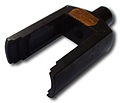Frame tool
As a special tool or framework tool is known tools that are designed specifically for work on the bicycle frame.
A case with these and other bicycle tools, known as the "Campa case", was first offered by the Campagnolo company , today there are also inexpensive alternatives.
Basics
Working with these tools requires tact and experience. The frame was destroyed very quickly if handled incorrectly. Expensive racing bikes should be milled flat on the bottom bracket, fork cone and head tube before final assembly; if there are paint residues, correct assembly of the bearings is usually impossible. Cutting oil must be used when milling and re-cutting the threads .
The work that is carried out with these special tools is partly possible with conventional tools, but then there is a higher risk of injury and assembly is less precise.
tax rate
Fork cone knockers
This tee removes the fork cone, which sits positively on the fork. When knocking off with a punch, the cone tilts and damages the seat of the fork. The tool is suitable for cones of sizes 1 ", 1 1/4" and 1 1/8 "at the same time. The fork crown may be a maximum of 32 mm thick.
To knock off the cone, the fork is clamped in a vice. To prevent the fork from slipping, it is better to clamp it horizontally.
Fork cone cutter
This milling tool is used when a secure fit of the fork cone is no longer guaranteed due to incorrect dismantling or repainting. If paint residue is left on the fork, the cone will settle within a short time during operation, and the headset must be constantly readjusted.
Headset milling cutter
For the seat of the tax rate the same applies as for the crown race. Often there is paint residue on new bikes, which makes correct assembly of the headset impossible.
Fork cone impactor
With this hammer, fork cones are opened cleanly. This only works if the seat of a new fork has been milled flat beforehand. The impact is done by hand, the relatively heavy weight of this tool makes this possible.
Expeller for headset cups
The dismantling of the headset cups is also possible with a hammer and screwdriver, the risk of injury is high, there is also a risk of the bearing cups tilting and thus damaging the frame. The extractor guarantees quick and clean dismantling of the bearing shells.
Headset press tool
Provisionally can the tax rate Press in with vice or fork, an accurate result can be obtained only with the press tool.
Bottom bracket
Face mill bottom bracket
The bottom bracket shells are usually screwed in today. If exist on the frame paint residues or other inaccuracies, which can Braquet not install correctly because the bearings can put under load. For this reason, they are milled flat on high-quality wheels. The tool is inserted with the cutter side and fixed on the opposite side with a cone and a spring. The spring tension can be just high enough that the cutter is pressed down; if you do not use cutting oil or the spring tension is too high, the cutter will "rub" and result in an unclean result.
Tap bottom bracket
After repainting or incorrect installation of the bottom bracket shell, it may be necessary to recut the bottom bracket thread.
The taps must always be set on both sides, their use guarantees the creation of an optimal coaxiality of the thread in the frame. If this is not the case, the bottom brackets run hard and wear out prematurely.
Control gauge for circuit eye
If the gear eye is only slightly bent, the derailleur can no longer be adjusted precisely. A makeshift alignment can be achieved by screwing a front wheel into the gear eye; the gear eye can be aligned very precisely with the special tool.
Control gauge for dropouts
The bell-shaped control gauges are screwed into the dropouts and allow coplanar Aim of the dropouts, which is important for proper function of the rear derailleur.
literature
- Rob van der Plas: The bicycle workshop - repair and maintenance step by step. 1st edition, BVA Bielefelder Verlaganstalt, Bielefeld, 1995, ISBN 3-87073-147-8









